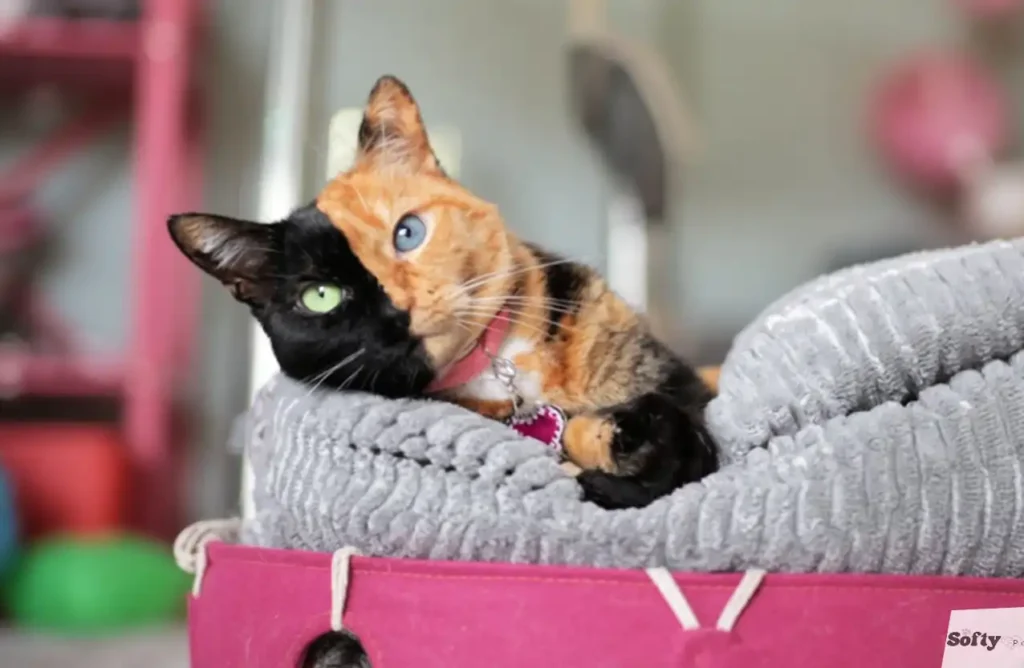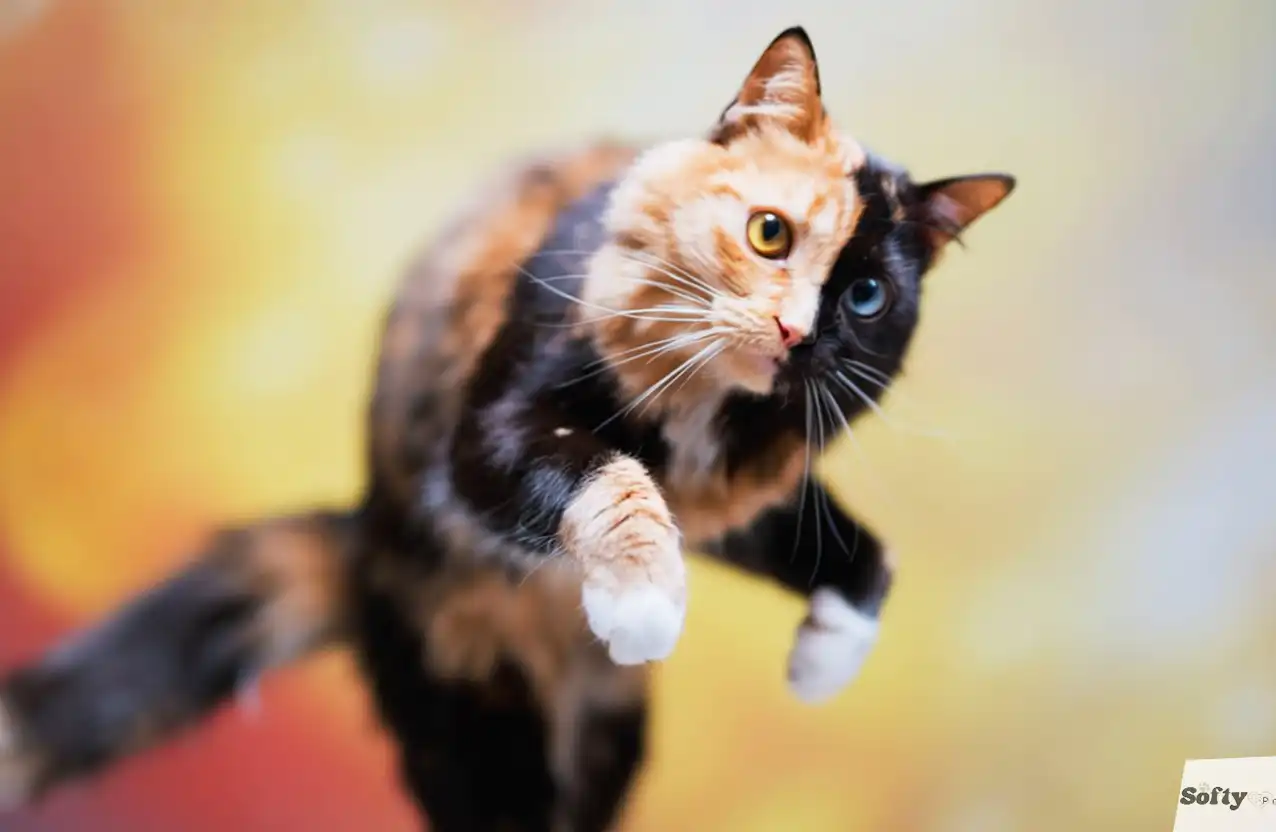Every cat has its own charm, but some felines stop you mid-scroll. Maybe it’s a perfectly split face, a patch of color that looks too exact to be real, or eyes that seem borrowed from two different cats. These are the photos that make people whisper, “Is this a chimera?”
Over the past few years, several of these striking cats have taken over Instagram and TikTok, sparking millions of likes and endless debates about whether they’re real or just clever filters. As someone who’s raised more cats than I can count—and spent years studying coat genetics—I find the stories behind these famous faces just as fascinating as their looks.
let’s meet a few of the most talked-about “chimera cats,” explore what science says about them, and separate verified fact from viral fantasy.
Venus: The Cat That Started It All
No discussion about chimera cats is complete without mentioning Venus, the feline who practically defined the trend. Her photo first appeared online more than a decade ago — half jet-black, half orange, with one green eye and one blue. The internet immediately crowned her “the two-faced cat.”
What made Venus special wasn’t just her color split, but how precise it appeared. People assumed she had to be digitally edited, yet multiple photos and videos confirmed she was very real. Over time, geneticists weighed in, explaining that while Venus might be a chimera, she could also be a mosaic — a cat with one set of DNA, but natural mutations that produce dramatic patterns.
Regardless of the science, Venus opened the world’s eyes to how incredible feline genetics can be. Every new “chimera cat” that pops up today owes a little of its fame to her.

Quimera and the Rise of Verified Chimeras
After Venus captured the world’s attention, another cat from Argentina stepped into the spotlight — Quimera. Her face, almost evenly divided between black and orange, reignited the conversation about what makes a true chimera.
Unlike many viral pets, Quimera’s owners and veterinarians were open about her story. Her markings were completely natural, and her photos were verified without editing or filters. While she hasn’t undergone public DNA testing, her unique fur and heterochromatic eyes (one amber, one blue) made her one of the most visually convincing examples of chimerism ever seen online.
Quimera’s fame also did something more important: it helped people discover the science behind coat color. Thousands of cat lovers started learning about embryonic fusion, genetic mosaicism, and chromosome expression, turning viral curiosity into genuine education.
Other Cats That Captivated the Internet
While Venus and Quimera remain the poster cats for chimerism, several others have quietly earned admiration in the cat community for their unusual looks.
There’s a rescue tabby from the United States, featured in a veterinary genetics study, whose cheek swab revealed two distinct DNA profiles — confirming she was a true chimera. Another cat, discovered in a European shelter, displayed a distinct divide between gray and orange fur and heterochromatic eyes, later verified by lab testing.
Even cats without lab confirmation—like Apricot, a Tennessee rescue with a half-and-half face—have helped raise awareness for adoption and pet genetics. Each viral post sparks the same question: how does this happen? And every time someone digs for that answer, a bit more truth about feline biology reaches new audiences.
How Social Media Shapes the Chimera Story
Social media has been both a blessing and a blur when it comes to chimera cats, platforms like Instagram and TikTok can turn a single photo into a global sensation overnight, but they also blur the line between what’s genetically real and what’s digitally enhanced.
Some accounts share beautifully lit, genuine images that highlight a cat’s natural coat. Others rely on filters or editing tools that make patterns appear sharper or colors more divided than they really are. The result? Millions of users amazed, inspired—and sometimes misled.
I always remind my followers: don’t assume every perfect split-face you see online is a scientific rarity. Enjoy the art, but check the source. The real cats—like Venus, Quimera, and the verified rescues—don’t need editing to look extraordinary. Their authenticity is what makes them timeless.
Jake’s Take: The Real Beauty Behind the Fame
What I love most about these famous cats isn’t the fame itself, it’s how their stories remind people that science can be beautiful, whether a cat is a verified chimera or simply blessed with incredible markings, every one of them proves how creative nature can be.
To me, that’s the real reward of these viral moments. They start with curiosity and end with learning. If a few seconds of scrolling lead someone to discover the wonder of feline genetics—or even adopt a rescue cat with a quirky pattern—then social media has done something good.
A perfect face split might catch attention, but it’s the story behind the markings that keeps people inspired, and as someone who’s spent a lifetime around cats, I can tell you: there’s magic in every coat, chimera or not.
Quick Answers
Who is the most famous chimera cat?
Venus remains the best-known example, but Quimera from Argentina and several verified rescue cats have also drawn worldwide attention.
Are viral chimera cats always real?
Not always. Some are genuine, but many photos online exaggerate color patterns through lighting or editing. Only a DNA test can confirm chimerism.
What makes these cats special?
They visually show how genetics can create art—each pattern tells a biological story, whether it’s chimerism or mosaicism.
Can a normal cat look like a chimera?
Yes calico, tortoiseshell, and even tabby patterns can mimic a chimera’s look without dual DNA.
How do I know if my cat might be one?
DNA testing is the only sure way. Kits like Basepaws or Wisdom Panel can compare samples from different body parts to check for multiple DNA profiles.
Fascinated by these one of a kind cats?
Explore my guide on How to Tell If Your Cat Is a Chimera.
- Famous Chimera Cats on Instagram and TikTok - October 20, 2025
- Are Chimera Cats Real or a Myth? - October 19, 2025
- How to Tell If Your Cat Is a Chimera? Signs, Genetics & Testing - October 16, 2025
